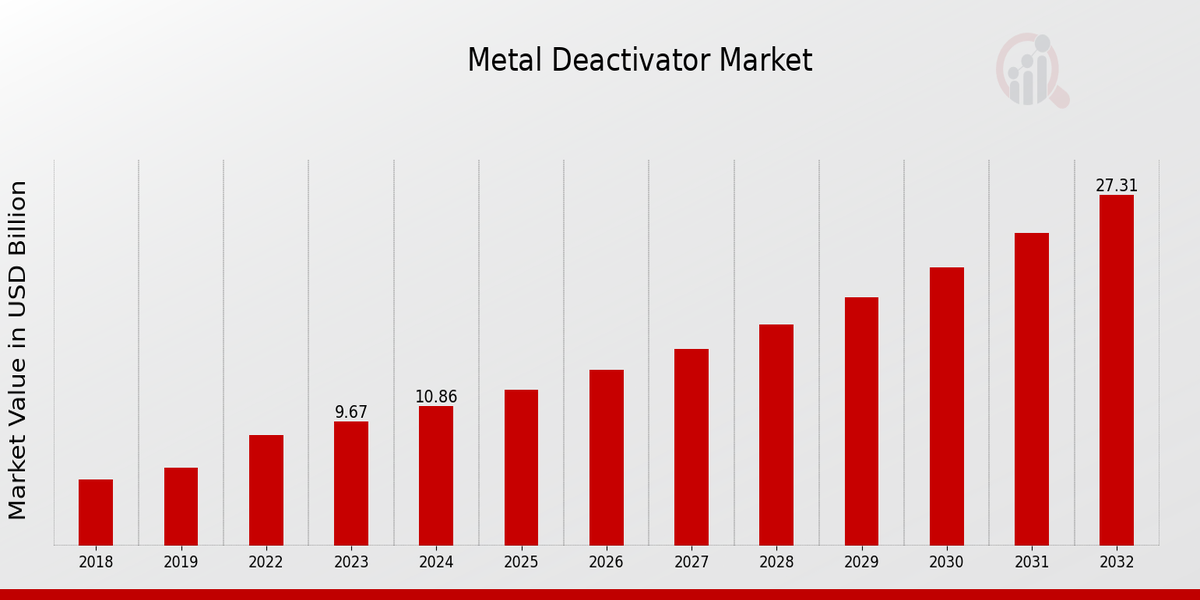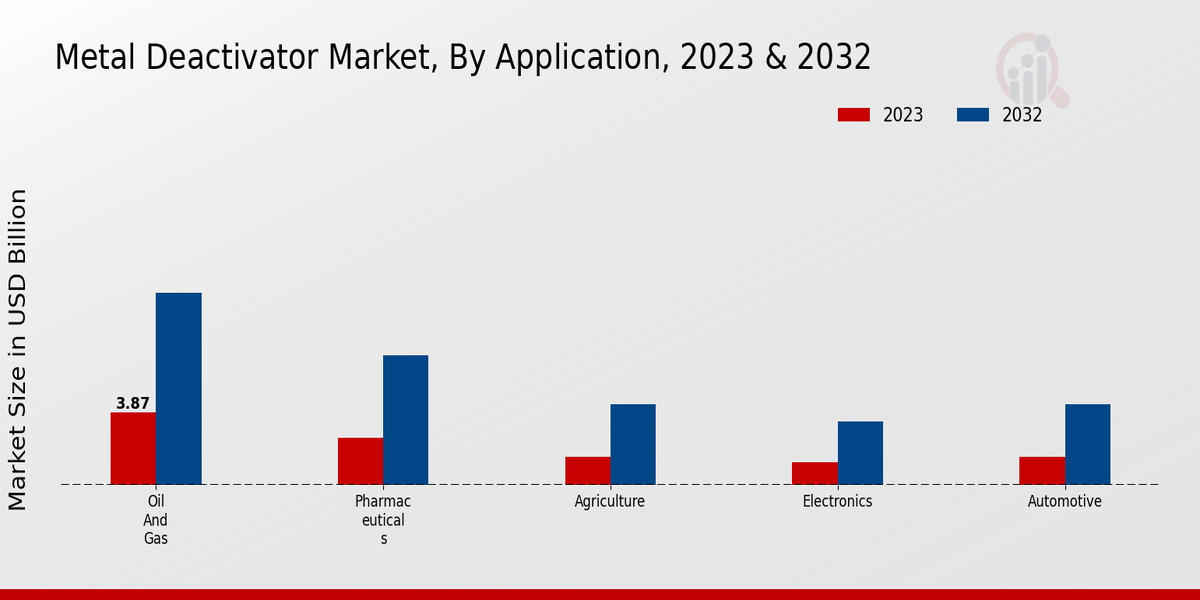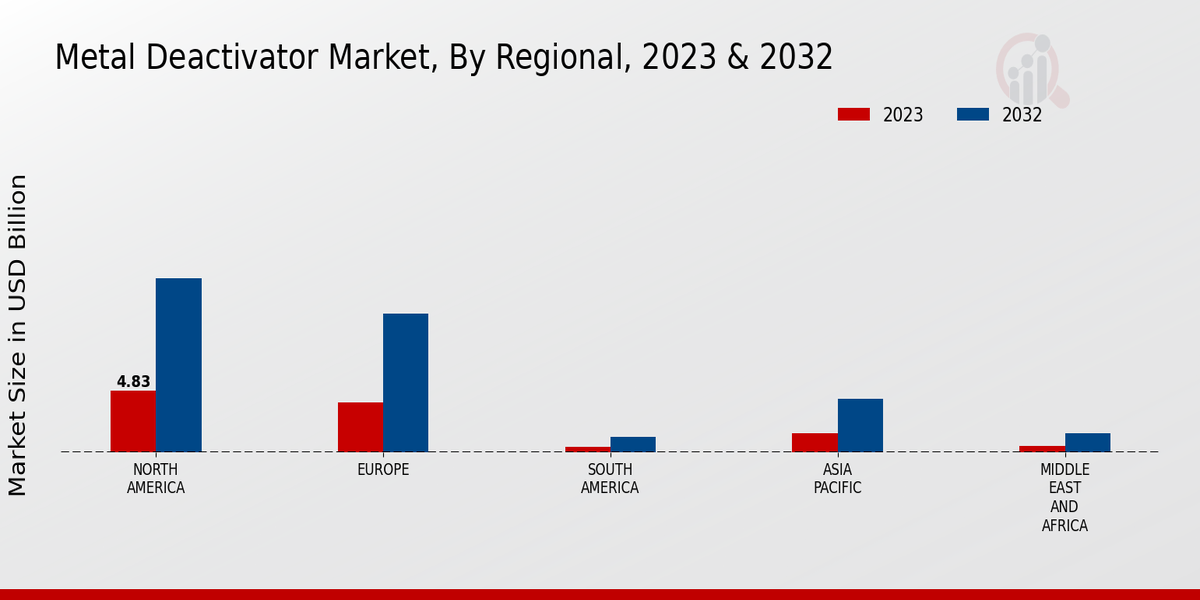Global Metal Deactivator Market Overview
The Metal Deactivator Market Size was estimated at 8.62 (USD Billion) in 2022. The Metal Deactivator Industry is expected to grow from 9.67(USD Billion) in 2023 to 27.3 (USD Billion) by 2032. The Metal Deactivator Market CAGR (growth rate) is expected to be around 12.22% during the forecast period (2024 - 2032).
Key Metal Deactivator Market Trends Highlighted
Key market drivers for metal deactivators include the growing demand for high-purity metals and chemicals in various industries such as electronics, pharmaceuticals, and automotive. Stringent environmental regulations and increasing concerns over metal contamination are also driving the adoption of metal deactivators. Opportunities in the metal deactivator market lie in the development of innovative and efficient deactivation technologies. The integration of advanced manufacturing processes, such as nanotechnology, offers promising avenues for improving deactivation performance and expanding the range of applicable metals. Additionally, expanding into emerging markets and exploring new application areas presents significant growth potential. Recent trends in the metal deactivator market include the increasing adoption of eco-friendly and sustainable deactivation solutions. The demand for heavy metal-free deactivators and advancements in biodegradable formulations have gained traction, aligning with the growing focus on environmental responsibility. Moreover, the development of multifunctional deactivators that can handle multiple metals or provide additional benefits, such as corrosion protection, is gaining interest.
Source: Primary Research, Secondary Research, MRFR Database and Analyst Review
Metal Deactivator Market Drivers
Rising Demand for Metal Deactivators in the Automotive Industry
The automotive industry is a major consumer of metal deactivators. Metal deactivators are used in the production of automotive parts, such as engine components, brake pads, and catalytic converters. The growing demand for automobiles, particularly in emerging markets, is expected to drive the growth of the metal deactivators market. Additionally, the increasing adoption of lightweight materials, such as aluminum and magnesium, in automotive manufacturing is also expected to boost the demand for metal deactivators, as these materials are more prone to corrosion.The Metal Deactivator Market Industry is expected to witness steady growth in the coming years owing to the growing demand from the automotive sector. The automotive industry is one of the major end-use industries for metal deactivators, and the increasing production of automobiles is expected to drive the demand for metal deactivators. The demand for metal deactivators is likely to be influenced by the increasing need for vehicle corrosion protection due to the growing penetration of lightweight vehicles.
Growing Awareness of Corrosion Prevention
Corrosion is a major problem for metal structures, such as bridges, buildings, and pipelines. Metal deactivators can be used to protect metal structures from corrosion by forming a protective layer on the metal surface. The growing awareness of the importance of corrosion prevention is expected to drive the growth of the metal deactivators market. Governments and industries are increasingly implementing regulations and standards to prevent corrosion, which is expected to boost the demand for metal deactivators.
Technological Advancements in Metal Deactivation
The metal deactivators market is constantly evolving, with new technologies being developed to improve the performance and efficiency of metal deactivators. These technological advancements are expected to drive the growth of the metal deactivators market. For example, the development of nanotechnology-based metal deactivators is expected to provide improved corrosion protection and longer service life.
Metal Deactivator Market Segment Insights
Metal Deactivator Market Application Insights
The application segment plays a crucial role in shaping the dynamics of the Metal Deactivator Market. Among the key applications, Oil and Gas holds a significant market share, driven by the increasing demand for metal deactivators in refining processes to prevent catalyst poisoning and ensure optimal performance. The Pharmaceuticals industry is another major application segment, utilizing metal deactivators to enhance drug stability, prevent discoloration, and improve product quality. In the Agriculture sector, metal deactivators are employed to chelate metal ions in fertilizers, enhancing nutrient uptake and crop yield.The Electronics industry leverages metal deactivators to protect electronic components from corrosion and maintain their functionality. This growth is attributed to the rising demand for metal deactivators across various industries, coupled with the increasing adoption of advanced technologies and the growing awareness of the importance of metal deactivation in various processes.
Source: Primary Research, Secondary Research, MRFR Database and Analyst Review
Metal Deactivator Market Type Insights
The Metal Deactivator Market is segmented based on Type into Organic Metal Deactivators, Inorganic Metal Deactivators and Polymeric Metal Deactivators. In 2023, Organic Metal Deactivators accounted for the largest revenue share, owing to their ability to effectively deactivate metal ions and prevent the formation of metal soaps and deposits. Inorganic Metal Deactivators are expected to witness significant market growth due to their cost-effectiveness and compatibility with various formulations. Polymeric Metal Deactivators are gaining popularity due to their ability to provide long-lasting effects and stability against harsh conditions. The Metal Deactivator Market is expected to reach USD 12.22 billion by 2032, exhibiting a CAGR of 12.22% during the forecast period.
Metal Deactivator Market Additive Form Insights
The Metal Deactivator Market segmentation by Additive Form includes Liquid, Powder and Granules. Among these, the Liquid segment held the largest market share in 2023, and it is expected to continue its dominance throughout the forecast period. The growth of the Liquid segment can be attributed to its ease of handling and application, as well as its compatibility with a wide range of metalworking fluids. The Powder segment is expected to witness significant growth during the forecast period due to its ability to provide higher metal deactivation efficiency and its suitability for use in high-volume metalworking operations. The Granules segment is anticipated to grow at a steady pace during the forecast period, owing to its cost-effectiveness and its ability to be used in both aqueous and non-aqueous metalworking fluids.
Metal Deactivator Market End-Use Industry Insights
The end-use industry segment of the Metal Deactivator Market encompasses a diverse range of industries that utilize metal deactivators in their manufacturing processes. Key end-use industries include Metals and Mining, Rubber and Plastics, Paper and Pulp, Paints and Coatings and Leather. Metals and Mining: Metal deactivators play a crucial role in the extraction and processing of metals, helping to prevent unwanted reactions and improve metal quality. The growing demand for metals in various industries, such as automotive and construction, is expected to drive the growth of the metal deactivators market in this segment.Rubber and Plastics: Metal deactivators are essential in the production of rubber and plastic products, as they prevent the formation of unwanted metal ions that can affect the properties and performance of these materials. The increasing use of rubber and plastics in various applications, including automotive, packaging and consumer goods, is expected to contribute to the growth of the metal deactivators market in this segment. Paper and Pulp: Metal deactivators are used in the paper and pulp industry to prevent the discoloration and degradation of paper products caused by metal ions.The growing demand for paper and pulp products, particularly in emerging economies, is expected to drive the growth of the metal deactivators market in this segment. Paints and Coatings: Metal deactivators are widely used in the paints and coatings industry to prevent the formation of metal soaps, which can affect the appearance and performance of coatings. The increasing demand for paints and coatings in various applications, such as automotive, construction and industrial, is expected to contribute to the growth of the metal deactivators market in this segment.Leather: Metal deactivators are essential in the leather industry to prevent the discoloration and deterioration of leather products caused by metal ions. The growing demand for leather products, particularly in the fashion and luxury goods industries, is expected to drive the growth of the metal deactivators market in this segment.
Metal Deactivator Market Regional Insights
The regional segmentation of the Metal Deactivator Market provides insights into the performance of the market across different geographic regions. North America is expected to hold a significant share of the market in 2023 and is projected to continue its dominance throughout the forecast period. The presence of major automotive and manufacturing industries in the region is a key factor driving the growth of the Metal Deactivator Market in North America. Europe is another important region for the Metal Deactivator Market, with Germany, France, and the United Kingdom being the major contributors.The growing demand for metal deactivators in the automotive and electronics industries is supporting the growth of the market in Europe. The Asia-Pacific region is projected to witness the highest growth rate during the forecast period. China and India are the key markets in this region, driven by the increasing demand for metal deactivators in the automotive, construction and electronics industries. South America and the Middle East Africa are expected to contribute a smaller share to the Metal Deactivator Market but are projected to grow steadily over the forecast period.
Source: Primary Research, Secondary Research, MRFR Database and Analyst Review
Metal Deactivator Market Key Players And Competitive Insights
Major players in the Metal Deactivator Market industry are constantly striving to gain an edge over their competitors. They invest heavily in research and development to introduce innovative products and technologies that cater to the evolving needs of customers. Leading Metal Deactivator Market players adopt various strategies such as mergers and acquisitions, partnerships, and collaborations to expand their global footprint and strengthen their market position. The competitive landscape of the Metal Deactivator Market is fragmented, with a few dominant players and several smaller regional players. These players compete on factors such as product quality, price, distribution network, and customer service. Key industry participants focus on enhancing their product offerings and expanding their distribution channels to gain a competitive advantage.One of the leading competitors in the Metal Deactivator Market is LANXESS, a global specialty chemicals company headquartered in Germany. LANXESS offers a comprehensive portfolio of metal deactivators under its Levanyl brand. These products are designed to prevent metal ions from interfering with the performance of plastics, paints, and other materials. LANXESS has a strong global presence with manufacturing facilities in Europe, Asia, and the Americas. The company's extensive distribution network and technical expertise enable it to cater to the needs of customers worldwide.Another major player in the Metal Deactivator Market is Songwon Industrial Co., Ltd., a South Korea-based company specializing in the production of specialty chemicals and plastics. Songwon offers a range of metal deactivators under its Songnox brand. These products are widely used in the plastics, rubber, and coatings industries. Songwon has a global manufacturing footprint with facilities in Asia, Europe, and the Americas. The company's commitment to innovation and customer service has positioned it as a trusted supplier in the Metal Deactivator Market.
Key Companies in the Metal Deactivator Market Include
- Evonik Industries
- Eastman Chemical Company
- Huntsman Corporation
- BASF
- Rhodia
- Lanxess
- Quaker Chemical Corporation
- Clariant
- Univar Solutions
- Milliken Company
- Stepan Company
- Solvay
- Lubrizol Corporation
- Dow Chemical Company
Metal Deactivator Market Industry Developments
The global metal deactivator market is projected to reach USD 27.3 billion by 2032, exhibiting a CAGR of 12.22% during the forecast period. Rising demand for metal deactivators in various industries, particularly in the automotive and aerospace sectors, is driving market growth. Metal deactivators are essential for preventing corrosion and improving the performance and durability of metal components.Recent developments in the market include the launch of eco-friendly and biodegradable metal deactivators, which are gaining popularity due to increasing environmental concerns. Additionally, advancements in nanotechnology have led to the development of nano-sized metal deactivators, which offer improved efficiency and performance.Key market players are focusing on strategic partnerships, acquisitions, and product innovations to expand their market presence. For instance, in 2023, BASF acquired the metal deactivator business of Clariant, strengthening its position in the market.
Metal Deactivator Market Segmentation Insights
Metal Deactivator Market Application Outlook
- Oil and Gas
- Pharmaceuticals
- Agriculture
- Electronics
- Automotive
Metal Deactivator Market Type Outlook
- Organic Metal Deactivators
- Inorganic Metal Deactivators
- Polymeric Metal Deactivators
Metal Deactivator Market Additive Form Outlook
Metal Deactivator Market End-Use Industry Outlook
- Metals and Mining
- Rubber and Plastics
- Paper and Pulp
- Paints and Coatings
- Leather
Metal Deactivator Market Regional Outlook
- North America
- Europe
- South America
- Asia Pacific
- Middle East and Africa
| Report Attribute/Metric |
Details |
| Market Size 2022 |
8.62(USD Billion) |
| Market Size 2023 |
9.67(USD Billion) |
| Market Size 2032 |
27.3(USD Billion) |
| Compound Annual Growth Rate (CAGR) |
12.22% (2024 - 2032) |
| Report Coverage |
Revenue Forecast, Competitive Landscape, Growth Factors, and Trends |
| Base Year |
2023 |
| Market Forecast Period |
2024 - 2032 |
| Historical Data |
2019 - 2023 |
| Market Forecast Units |
USD Billion |
| Key Companies Profiled |
Evonik Industries, Eastman Chemical Company, Huntsman Corporation, BASF, Rhodia, Lanxess, Quaker Chemical Corporation, Clariant, Univar Solutions, Milliken Company, Stepan Company, Solvay, Lubrizol Corporation, Dow Chemical Company |
| Segments Covered |
Application, Type, Additive Form, End-Use Industry, Regional |
| Key Market Opportunities |
1. Polyolefin and styrenic polymers are increasing automotive production. 2. Growing aerospace industry using lightweight metals 3. Advances in polymer processing techniques 4. Rising demand for biobased polymers 5. Expansion of 3D printing in manufacturing |
| Key Market Dynamics |
1. Market demand expansion due to growing pharmaceutical and food industries 2. Rising prevalence of metal ions in industrial processes 3. Increasing awareness of the adverse effects of metal ions 4. Technological advancements in metal deactivation techniques 5. Emergence of eco-friendly and sustainable deactivators |
| Countries Covered |
North America, Europe, APAC, South America, MEA |
Frequently Asked Questions (FAQ) :
The Metal Deactivator Market is expected to reach USD 9.67 billion by 2023, with a CAGR of 12.22% between 2023 and 2032. The market growth is attributed to the rising demand for metal deactivators in various industries, including oil and gas, petrochemical, and automotive.
Asia-Pacific is expected to dominate the Metal Deactivator Market, accounting for over 40% of the market share in 2023. The growth in this region is attributed to the increasing industrialization and urbanization in countries such as China, India, and Japan.
Metal deactivators are primarily used in the following applications: - Oil and gas industry: To prevent corrosion and fouling in pipelines, storage tanks, and other equipment. - Petrochemical industry: To remove metal contaminants from petroleum products, such as gasoline, diesel and jet fuel. - Automotive industry: To protect metal components from corrosion and wear in engines, transmissions and other systems.
The key competitors in the Metal Deactivator Market include: - BASF SE - Clariant AG - Croda International Plc - Evonik Industries AG - Lubrizol Corporation - Nouryon - Solvay S.A.
The major growth drivers of the Metal Deactivator Market include: - Increasing demand for metal deactivators in oil and gas, petrochemical, and automotive industries. - Growing awareness about the importance of corrosion prevention. - Stringent government regulations on environmental protection. - Technological advancements in metal deactivator formulations.
The major challenges faced by the Metal Deactivator Market include: - Fluctuating raw material prices. - Intense competition from both domestic and international players. - Stringent environmental regulations on the use of metal deactivators.
The future trends of the Metal Deactivator Market include: - Development of more effective and environmentally friendly metal deactivators. - Increasing demand for metal deactivators in emerging markets. - Growing adoption of metal deactivators in new applications, such as renewable energy and electronics.
The COVID-19 pandemic had a negative impact on the Metal Deactivator Market in the short term. However, the market is expected to recover in the long term as industries resume their operations and demand for metal deactivators increases.
The major opportunities for growth in the Metal Deactivator Market include: - Expanding into new applications, such as renewable energy and electronics. - Developing new and innovative metal deactivator formulations. - Targeting emerging markets with high growth potential.
The key strategies adopted by players in the Metal Deactivator Market include: - Product innovation and development. - Expansion into new markets. - Partnerships and collaborations with other companies. - Acquisitions and mergers.

















